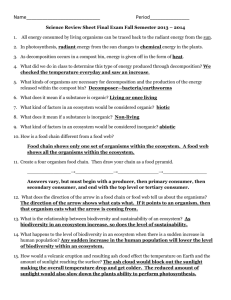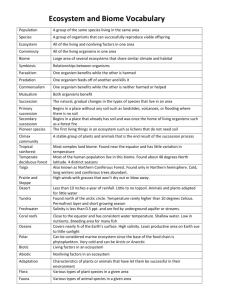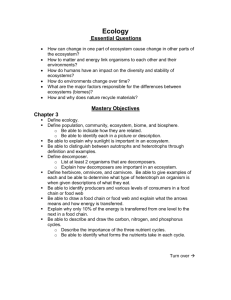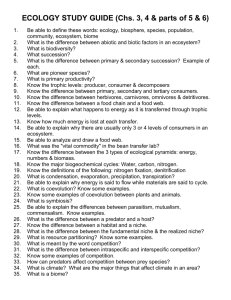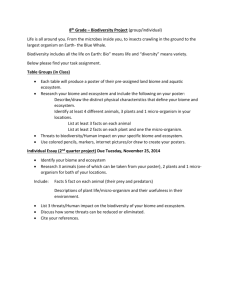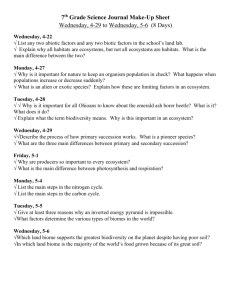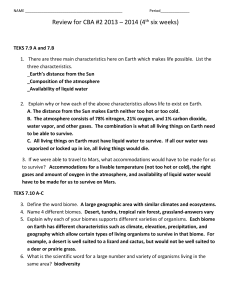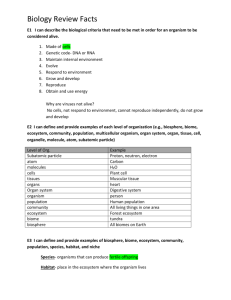Answer Key Semester Exam Review 2015-2016
advertisement
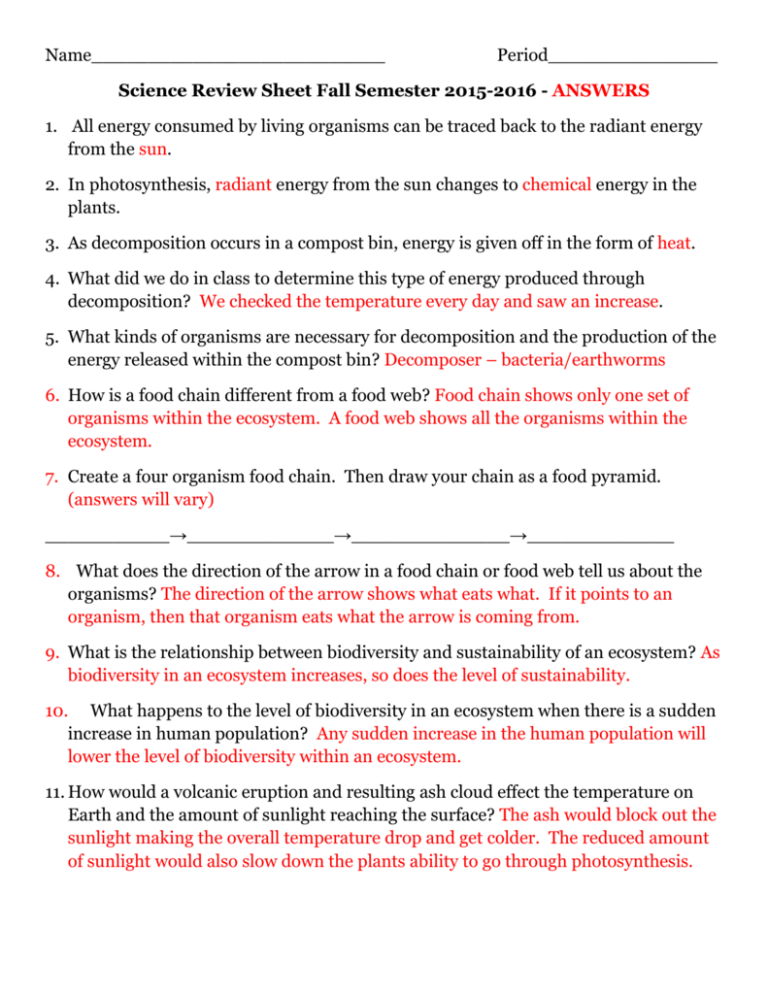
Name__________________________ Period_______________ Science Review Sheet Fall Semester 2015-2016 - ANSWERS 1. All energy consumed by living organisms can be traced back to the radiant energy from the sun. 2. In photosynthesis, radiant energy from the sun changes to chemical energy in the plants. 3. As decomposition occurs in a compost bin, energy is given off in the form of heat. 4. What did we do in class to determine this type of energy produced through decomposition? We checked the temperature every day and saw an increase. 5. What kinds of organisms are necessary for decomposition and the production of the energy released within the compost bin? Decomposer – bacteria/earthworms 6. How is a food chain different from a food web? Food chain shows only one set of organisms within the ecosystem. A food web shows all the organisms within the ecosystem. 7. Create a four organism food chain. Then draw your chain as a food pyramid. (answers will vary) ___________→_____________→______________→_____________ 8. What does the direction of the arrow in a food chain or food web tell us about the organisms? The direction of the arrow shows what eats what. If it points to an organism, then that organism eats what the arrow is coming from. 9. What is the relationship between biodiversity and sustainability of an ecosystem? As biodiversity in an ecosystem increases, so does the level of sustainability. 10. What happens to the level of biodiversity in an ecosystem when there is a sudden increase in human population? Any sudden increase in the human population will lower the level of biodiversity within an ecosystem. 11. How would a volcanic eruption and resulting ash cloud effect the temperature on Earth and the amount of sunlight reaching the surface? The ash would block out the sunlight making the overall temperature drop and get colder. The reduced amount of sunlight would also slow down the plants ability to go through photosynthesis. 12.What 3 processes could change the appearance of mountains, beaches, islands, or any natural landform? Weathering and erosion, then deposition would drop the weathered and eroded material in a new location. 13. Explain how the following areas might be most affected by weathering and erosion? a. Beach: Wave erosion would continuously change the shape of the coastline as sand is eroded away in some areas and deposited in new areas. Winds would also change some of the area resulting in the formation of sand dunes. b. Desert: Mostly impacted by wind erosion creating changes in rocks due to abrasion and the formation/destruction of sand dunes. This is the most damaged ecosystem because of the lack of vegetation. c. Grassland/Prairie: Mostly impacted by erosion caused by flooding (moving water). This can remove the top soil. 14.What happens to the sediment which is eroded away during a flood? The sediment that erodes away during a flood usually ends up in a river where it will be deposited at the point the river meets the ocean. 15. Why can’t some plants and animals survive when removed from their biome and placed in another biome? When moved to another biome, plants and animals often are unable to adapt quickly enough to the different abiotic and biotic factors in the new biome and will not survive. 16.In what biome would plants benefit from having shallow roots? Deserts Why? The desert biome has shallow roots because being close to the surface allows plants to quickly absorb the small amount of rain the region receives annually. 17. In which biome/s would it be helpful to have deeper roots? Grasslands Why? The deeper the roots because they help to keep the plant firmly rooted during times of high wind and they allow for the absorption of groundwater. 18. Explain how geotropism affects the roots and stems of seedlings? The roots grow down in response to gravity (positive geotropism the roots will grow down towards gravity and negative geotropism is when the stem grows upward against gravity). 19.Explain how plants respond to light. What is this called? Plants bend toward the light and this is called phototropism. 20. What force must spacecraft overcome to reach an orbit around the Earth? Gravity 21.List 4 ways in which a spacesuit allow astronauts to live and survive in space. Protection from space dust and other debris, provide oxygen, regulate temperature, and allows a place to tether or tie the astronaut to something for safety. 22. What percentage of oxygen would be necessary for us to survive in another planet’s atmosphere? 21% less than this amount we would not be able to survive. 23. List 3 main reasons life on Earth is possible. Life on Earth is possible because we have the correct mixture of gases in our atmosphere, we are the right distance from the sun so that we get neither too hot nor too cold, and we have liquid water. 24. How does leaking oil get into our groundwater? Leaking oil infiltrates the soil and then percolates through the soil and into our groundwater causing pollution. 25. What is the source of pollution which causes rapid growth of algae and changes in fish in our surface water? Nitrogen based fertilizers will run-off and enter surface water. 26. List 3 other types of pollution caused by human activity. Answers will vary. 27. What is the formula for work? W = F x D 28. What advantage does using a simple machine, like a ramp; give us in terms of work? Simple machines reduce the amount of force necessary to complete the job. 29. If you had to move a box into the back of a truck, what simple machine might you use to make the work easier? An inclined plane (ramp). 30. Solve these work problems & SHOW YOUR WORK: a) John uses 10 N of force to move a box 3 m Work = 3 x 10 = 30 Joules b) Sandra used an inclined plane to move a box 3 m and it took her 12 N of force. Work = 3 x 12 = 36 Joules 31.What is the difference between primary and secondary succession? Primary succession occurs in new areas of land with no soil, such as on a lava flow, a sand dune or moving glacier. Pioneer species are the first to appear in primary succession. Secondary succession occurs where existing ecosystems have been disturbed or destroyed by a catastrophic event. Secondary succession occurs faster because the soil already exists. 32. Define ecological succession: It is a process of one community gradually changing to another and that the process involves a series of steps.
